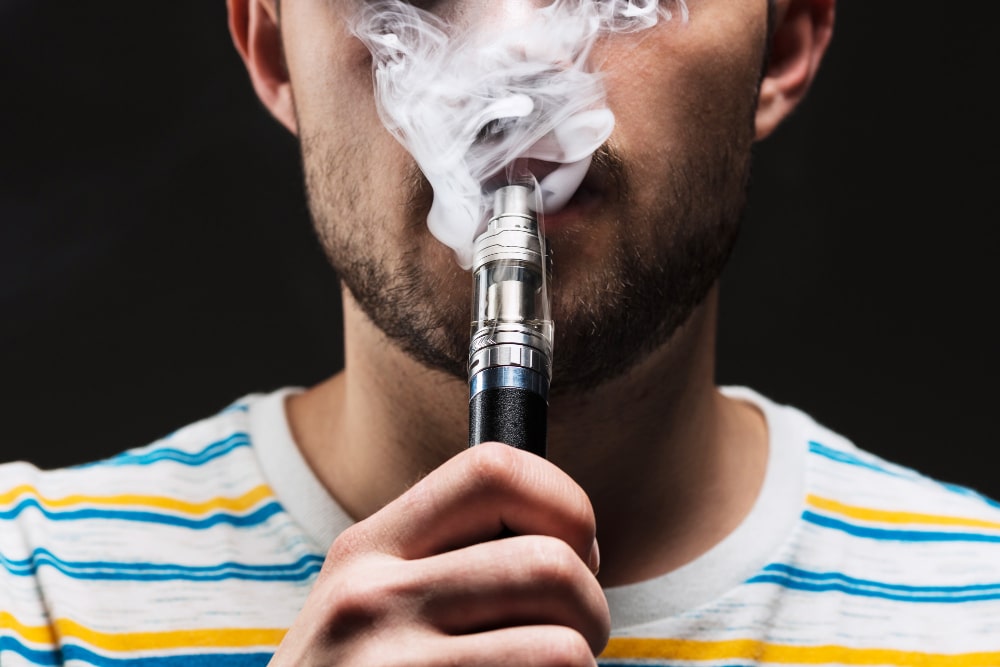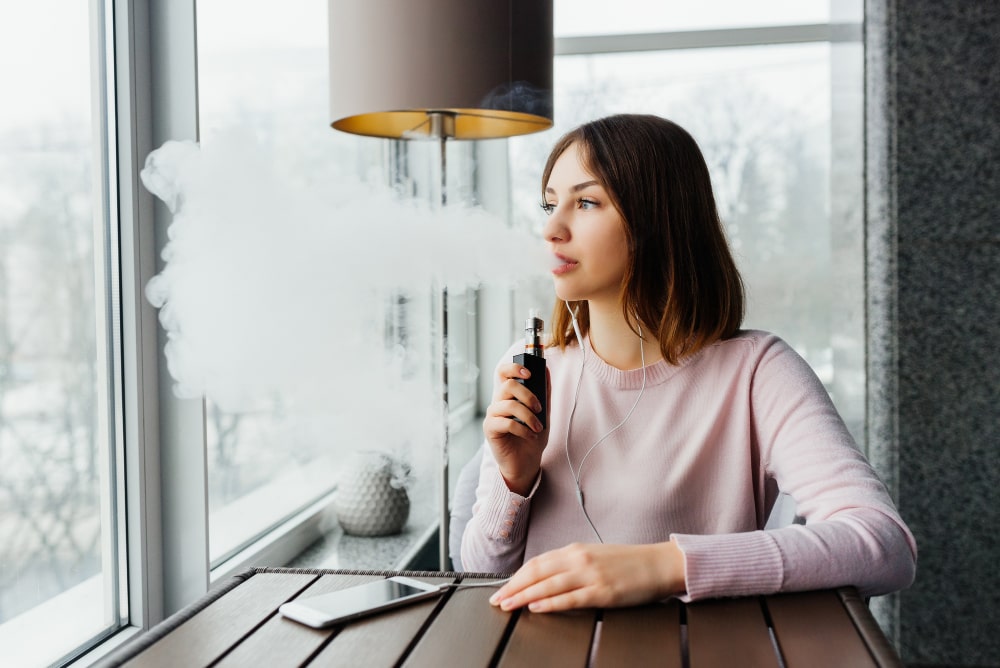Are Medical Marijuana Vapes Safe? Understanding the Risks and Benefits


Emmanuel Foret
Writer, Editor, Social Media Manager
March 13, 2025

Photo credit: iStock
Key Takeaways:
- Vaping medical marijuana carries potential risks, including lung injury and exposure to harmful substances like Vitamin E acetate, especially with unregulated products. Choosing lab-tested products from licensed dispensaries can reduce but not eliminate these risks.
- Safer alternatives to vaping, like edibles, tinctures, and topicals, offer effective symptom relief without compromising lung health. Patients should weigh the benefits and risks to make informed decisions about their medical marijuana use.
With the growing acceptance of medical marijuana, many patients explore vaping as a convenient and fast-acting method to manage symptoms. But alongside its popularity, concerns have surfaced about vaping’s safety, especially after reports of vaping-related lung injuries. So, the big question remains: Are medical marijuana vapes safe? Let’s dive into the science, potential dangers, and what you need to know to make an informed choice.
What Is Vaping and How Does It Work?
Vaping involves heating cannabis oil or flower to a temperature that releases active compounds (like THC and CBD) as vapor, without burning the plant material. People inhale this vapor through devices like vape pens, cartridges, or tabletop vaporizers. The appeal lies in vaping’s ability to provide fast relief — effects often kick in within minutes — and its reputation as a “cleaner” alternative to smoking.
But Are Medical Marijuana Vapes Safe? Let’s break it down.
The Perceived Benefits of Vaping
Many patients choose vaping over smoking for practical reasons:
- Faster Symptom Relief: Inhalation delivers cannabinoids into the bloodstream almost immediately, making it helpful for sudden symptom flare-ups like pain or nausea.
- Less Harsh on the Lungs (in theory): Because vaping avoids combustion, it eliminates harmful byproducts like tar and carbon monoxide that come from burning plant material.
- Convenience and Discretion: Vapes are portable, easy to use, and produce less odor than smoking, making them ideal for on-the-go use.
While these benefits are real, they don’t paint the full picture.
The Hidden Dangers of Vaping Marijuana
Despite avoiding the harms of smoke, vaping introduces its own risks — some of which are severe.
1. Lung Injuries and EVALI
In 2019, health officials identified an outbreak of EVALI (e-cigarette or vaping product use-associated lung injury), with over 2,500 hospitalizations and multiple deaths. Investigators traced many cases to THC vapes containing Vitamin E acetate, an additive used to thicken cannabis oils. When inhaled, this substance can severely damage lung tissue, causing symptoms like shortness of breath, chest pain, and even respiratory failure.
While many licensed dispensaries have phased out Vitamin E acetate, the incident highlighted how little we know about the long-term effects of vaping.
2. Exposure to Toxic Chemicals
Even without harmful additives, vaping can still introduce dangerous substances into the lungs:
- Heavy Metals: Vape device coils can degrade over time, releasing microscopic metal particles into the vapor.
- Carcinogens: Heating cannabis oil can produce cancer-causing chemicals, especially if the device reaches high temperatures.
- Ultrafine Particles: These tiny particles can penetrate deep into lung tissue, causing irritation and inflammation.
3. Potency and Overconsumption Risks
Vapes often contain concentrated cannabis extracts, which can be 2–3 times stronger than smoked flower. This potency makes it easy to consume too much THC too quickly, leading to unpleasant side effects like anxiety, paranoia, and dizziness. For patients new to cannabis or with low tolerance, this can be overwhelming.
Are Dispensary Vapes Safer?
If you choose to vape, buying from a licensed dispensary significantly reduces the risk of contamination. Dispensaries are required to test products for pesticides, heavy metals, and residual solvents, and many have publicly confirmed they don’t use harmful additives like Vitamin E acetate.
Still, experts recommend patients:
- Ask for Lab Reports: Reputable dispensaries should provide third-party lab results detailing the product’s contents.
- Avoid Black-Market Products: Illicit vapes are far more likely to contain dangerous chemicals or be mislabeled.
- Stick to Simple Ingredients: The fewer ingredients listed (ideally just cannabis oil and natural terpenes), the safer the product.
Get Your Florida Medical Marijuana Card Today! – Book Now!
Take the first step toward natural relief. Schedule your medical exam at The Card Clinic and see if you qualify for a Florida Medical Marijuana Card. Our compassionate doctors are here to guide you every step of the way.
Safer Alternatives to Vaping
For patients concerned about vaping’s risks, there are plenty of other ways to consume medical marijuana:
- Edibles: Cannabis-infused foods bypass lung risks entirely. They take longer to kick in (30–90 minutes), but effects last much longer than inhalation methods.
- Tinctures and Sublinguals: These liquid extracts are placed under the tongue for fast absorption, offering a smoke-free option with rapid effects.
- Topicals: Cannabis-infused creams or balms provide localized relief for pain and inflammation without entering the bloodstream or affecting the lungs.
- Dry Herb Vaporizers: If inhalation is your preference, a dry herb vaporizer may be a safer option than oil-based cartridges, as it heats ground cannabis flower without the need for solvents or thickeners.
“While vaping medical marijuana may seem safer than smoking, it carries hidden risks — from lung injuries to toxic chemicals. Knowing the facts helps you choose the safest path for your health.”
Tips for Vaping Safely
If vaping still feels like the best fit for your needs, follow these precautions to reduce risk:
- Start Low, Go Slow: Especially with potent vape oils, begin with a small dose and wait at least 20 minutes before re-dosing.
- Use Clean Devices: Regularly clean your vape pen to prevent residue buildup, which can degrade into harmful chemicals when reheated.
- Monitor for Symptoms: Pay attention to warning signs like chest pain, persistent coughing, or shortness of breath — and seek medical attention if they arise.
- Stay Informed: Research on cannabis vaping is still evolving, so keep an eye out for new findings and safety recommendations.
The Bottom Line: Is Vaping Medical Marijuana Safe?
The truth is, vaping comes with both benefits and risks. While it may be safer than smoking in some ways, it introduces its own unique set of health concerns — many of which we’re only beginning to understand.
For patients seeking fast relief, vaping can still be a viable option if done carefully and with high-quality, lab-tested products. But for those prioritizing long-term safety, exploring alternative methods like edibles or tinctures might be the better choice.
Ultimately, the safest approach is an informed one. By understanding the potential risks, staying cautious with product selection, and working closely with your healthcare provider, you can make the best decision for your health and well-being.
Would you like me to refine this, add more data, or craft a specific section? Let me know — I’m here to help! 🚀
Marijuana Guides
How to Get a Medical Marijuana Card in Florida: Everything You Need to Know
Marijuana Guides
How Long Does Weed Last in Ziploc? A Comprehensive Guide to Weed Storage
Marijuana Guides

